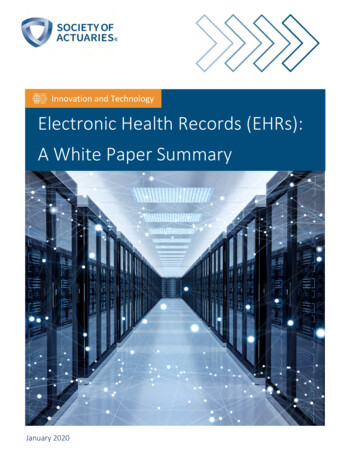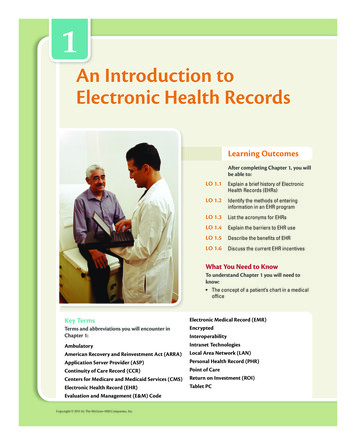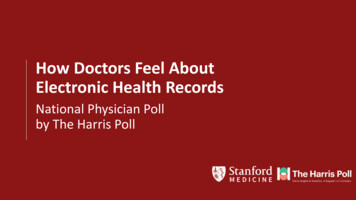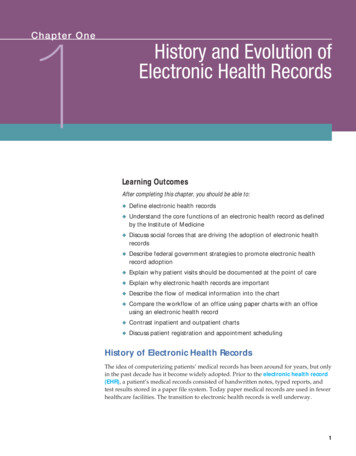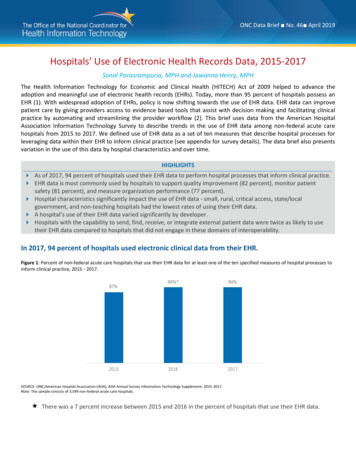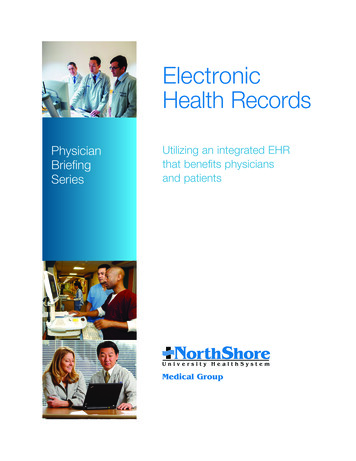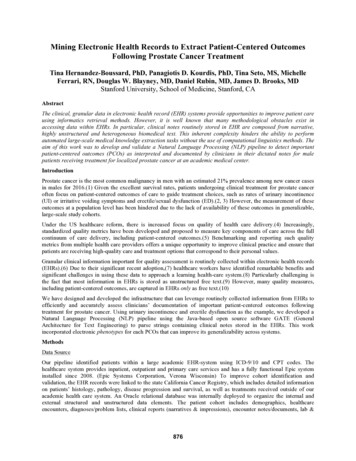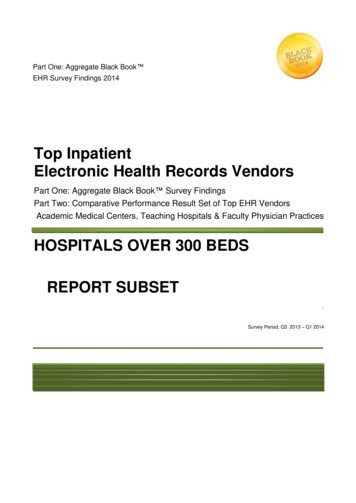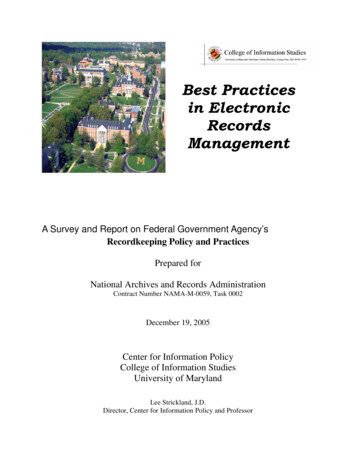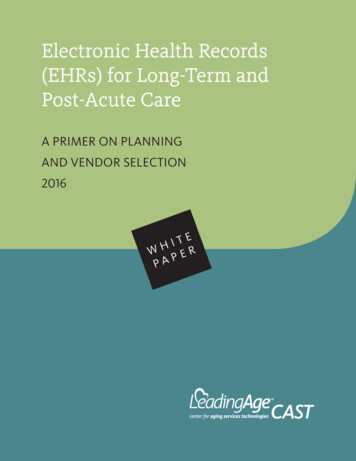
Transcription
Electronic Health Records(EHRs) for Long-Term andPost-Acute CareA PRIMER ON PLANNINGAND VENDOR SELECTION2016TEIWH ERPPA
ELECTRONIC HEALTH RECORDS (EHRS) FOR LONG-TERM AND POST-ACUTE CAREA PRIMER ON PLANNING AND VENDOR SELECTION2016A program of LeadingAge2519 Connecticut Ave., NWWashington, DC 20008-1520Phone (202) 508-9438Fax (202) 783-2255Web site: LeadingAge.org/CAST Copyright 2016 LeadingAgeLeadingAge Center for Aging Services Technologies:The LeadingAge Center for Aging Services Technologies (CAST) is focused on accelerating the development,evaluation and adoption of emerging technologies that will transform the aging experience. As an internationalcoalition of more than 400 technology companies, aging-services organizations, businesses, researchuniversities and government representatives, CAST works under the auspices of LeadingAge, an association of6,000 not-for-profit organizations dedicated to expanding the world of possibilities for aging.For more information, please visit LeadingAge.org/CAST
Contents1 Purpose and Executive Summary. 11.1 Purpose of White Paper.11.2 Executive Summary. 21.3 Disclaimer.32 Definitions. 42.1 Electronic Health Records (EHR).42.2 Electronic Medical Record (EMR).42.3 Personal Health Record (PHR).42.4 Health Information Technology (Health IT).43 Plan for and Implement an EHR System.53.1 Assess.53.1.1 Outline Vision and Strategic Plan.53.1.1.1 Software Applications.53.1.1.2 Hardware. 63.1.2 Assess Organizational Readiness: IT Infrastructure, IT Staffing, Skills & Attitudes. 73.1.2.1 Organizational Health IT Readiness Assessment. 73.1.2.2 Health IT Attitudes Assessment. 73.1.2.3 Computer Skills Survey. 73.1.2.4 IT Staffing Inventory. 83.1.2.5 IT System Inventory. 83.1.2.6 Health Information Exchange Readiness Inventory. 83.1.3 Assess Financials. 83.1.3.1 Financing Resources. 83.1.3.2 Sources of Funds. 93.2 Plan. 103.2.1 Set Goals. 103.2.1.1 Importance of Goals. 103.2.1.2 Writing Goals. 103.2.1.3 Templates for Tracking Goals.113.2.1.4 Resources for Goal Settings.11Telehealth and Remote Patient Monitoring for Long-Term and Post-Acute Care: A Primer and Provider Selection Guide 2016
3.2.2 Map Chart Data.123.2.2.1 Chart Conversion Planning.123.2.3 Workflow and Process Redesign. 133.2.3.1 Importance of Workflow and Process Improvement. 133.2.3.2 Process Mapping as a Means to Manage Change. 133.2.3.3 Workflow and Process Mapping. 133.2.3.4 Mapping Current Workflow and Processes. 133.2.3.5 Workflow and Process Redesign. 143.2.4 Different EHR Models. 143.3 Select.163.3.1 Vendor Selection.163.3.1.1 What Are You Buying?.163.3.1.2 The Marketplace.163.3.1.3 CAST 7-Stage EHR Adoption Model for Long-Term and Post-Acute Care (LTPAC).163.3.1.4 Price Ranges.203.3.1.5 Total Cost of Ownership and Return on Investment.213.3.1.6 Interoperability, Integration, Integration Engines, and Certification.213.3.1.7 Suggested EHR Selection Approach.244 EHR Selection Matrix Components.265 Acknowledgements.305.1 EHR Workgroup.305.2 Participating EHR Vendors. 316 Appendix. 326.1 Stratis Health - Toolkit for Home Health Agencies. 326.2 Stratis Health - Toolkit for Nursing Homes. 326.3 Stratis Health - Toolkit for Behavioral Health. 32Telehealth and Remote Patient Monitoring for Long-Term and Post-Acute Care: A Primer and Provider Selection Guide 2016
1 Purpose and Executive Summary1.1 Purpose of White PaperThis white paper updates our 2012, 2013, and 2014 white papers. The purpose of this paper is to aid LeadingAgemembers, CAST members, and other aging services organizations in choosing an Electronic Health Record(EHR) system that fits the needs of the organization, its providers, and its consumers, patients, and clients.This paper helps aging services organizations plan for and choose the best EHR system for their needs.Leading Age Minnesota (formerly Aging Services of Minnesota) contracted with Stratis Health of Bloomington,MN, to develop Health Information Technology (health IT) Toolkits for nursing homes and home healthagencies. In addition, recently Stratis Health developed a new toolkit on behavioral health that may haverelevance to providers that offer these types of services and/ or cater to individuals with intellectual disabilities.The purpose of these toolkits was to help organizations assess readiness, plan, select, implement, and makeeffective use of EHRs, as well as to exchange important information about the people they serve.LeadingAge and CAST helped LeadingAge Minnesota to promote the original toolkits, which help organizationsunderstand what they should look for in EHRs and the steps for implementation. These toolkits are publiclyavailable on the Stratis Health website. In 2013 -2014, Stratis Health updated the original toolkits to includemore information about interoperability and health information exchange. It also added a template to helpproviders estimate total cost of ownership and return on investments in EHRs. Our update of this white paperreflects the updates Stratis Health performed.This paper summarizes the important steps a provider should take while referencing the excellent StratisHealth toolkits. The paper then hones in on the next step of examining the fit of EHR products to theorganization, its processes, needs, and requirements, based on the functionalities these products offer. Next,the paper examines functionalities needed or desired in different lines of aging services within long-term andpost-acute care (LTPAC), including the following: LTPAC attending physicians. Home health/home care. Hospice. Adult day care. Assisted living facilities. Acute rehab facilities. Long-term acute care hospitals. Long-term care rehab facilities. Skilled nursing facilities. Intermediate care facilities. Intellectual disabilities/mental retardation/developmental disabilities (ID/MR/DD) facilities. Continuing care retirement communities (CCRC). Program of All-Inclusive Care for the Elderly (PACE). Vendors offering EHR systems specifically for LTPAC.Electronic Health Records (EHRs) for Long-Term and Post-Acute Care: A Primer on Planning and Vendor Selection 20161
CAST engaged experts from provider members and EHR vendor communities. We asked vendors to provideinformation in three areas: Implemented interoperability standards. Integration and health information exchange capabilities. Certification status and/or plans.You can also access the companion EHR Selection Matrix, online Selection Tool, and case studies.CAST collected, and will publish separately, case studies that highlight providers’ impacts and benefits of thefollowing: Clinical decision support systems, including those aimed at reducing inappropriate hospital admissionand acute care transfers (such as INTERACT, On-Time Quality Improvement, etc.), Interoperability and health information exchange with other care providers, either directly or through ahealth information exchange (HIE), and/or Analytic tools embedded in EHRs.This paper is available in a PDF format as well as a living HTML document with links. CAST updates the EHRSelection Matrix annually. We then use the matrix to update CAST’s online Selection Tool, which helps LTPACproviders choose an EHR system. Additional updates to the online Selection Tool take place as needed.This white paper and the companion EHR Selection Matrix, online CAST Electronic Health Records SelectionTool, and case studies continue CAST’s efforts to produce hands-on tools that help LTPAC providers adoptappropriate aging services technologies. These technologies enable providers to deliver innovative caredelivery models and position providers well for strategic partnerships and the future.EHRs, particularly interoperable ones that can exchange information with other providers and technologies,were the first enabling technology identified in the CAST strategic Scenario Planning exercise (please see ALook into the Future: Evaluating Business Models for Technology-Enabled Long-Term Services and Supports). Pleasealso review our Strategic Planning and Strategic IT Planning portfolio.1.2 Executive SummaryThe paper begins with definitions for Electronic Health Records (EHR), Electronic Medical Records (EMR),Personal Health Records (PHR) and Health Information Technology (health IT). It then explains the stepsinvolved in planning for and implementing electronic records, summarized from Section 3 of the Stratis HealthToolkits. Adopting technologies like these involves two steps:1.Assessing hardware, software, and staffing needs, and2. Assessing financial resources and sources of funds.Setting goals and measuring progress on goals are important steps.Planning and implementation stages include setting goals, moving towards those goals, measuring progress on,and ensuring that the organization is on track to meet those goals. Successful purchase and implementationElectronic Health Records (EHRs) for Long-Term and Post-Acute Care: A Primer on Planning and Vendor Selection 20162
involves the following: Mapping chart data, a process that aligns currently used data elements with the features of an EHR, Planning the conversion process, and Reviewing the workflow for opportunities to improve processes.These are essential to maximizing the benefits of health IT.There are differences between several models of EHRs, including locally hosted software, Application ServiceProviders (ASPs), and Software as a Service (SaaS). Each option has clear positives and negatives depending onan organization’s needs.The paper walks providers through the must-have attributes, functionalities, and features of an EHR system.Another key aspect is understanding what the organization is actually purchasing or leasing, what is available inthe marketplace, the price ranges, and whether the system can interoperate and integrate with other softwaresystems. The Vendor Selection section of the Stratis Health Toolkits assists with this task.The paper then walks providers through the must-have attributes, functionalities, and features they need toconsider before using the CAST EHR Selection Matrix and online EHR Selection Tool. The paper concludeswith an explanation of the main elements of the EHR Selection Matrix, which compares EHR products on225 features and functionalities. The matrix looks at each system’s fit for different business lines, integration,interoperability capabilities, certification status, software/hardware requirements, legal/regulatory compliance,cyberliability, and the vendor’s experience.Key information from the EHR Selection Matrix is used in an online EHR Selection Tool. With the tool, LTPACorganizations answer key questions to narrow their selections to a manageable list of EHR products that meettheir business line, care applicability needs, and essential requirements.1.3 DisclaimerThe information included in this paper is meant to assist in the understanding and selection of ElectronicHealth Record (EHR) systems. A few vendors elected not to participate. Functionalities and capabilities of listedEHR products are as reported by the vendors and have not been verified, tested, independently evaluated, orendorsed by LeadingAge or LeadingAge CAST. Products mentioned in this paper serve as illustrative examples.Please use this as a general guideline in understanding functionalities and examples of current EHR systems.The EHR Selection Matrix may help providers identify potential EHR solutions that may meet theirrequirements, as well as target vendors to invite to submit a Request for Proposal (RFP). Where appropriate,provider case studies have been identified and published separately. However, providers are strongly advised toverify functionalities of the EHRs prior to final selection through demonstrations, site visits, reference checking,and other due diligence.Learn the difference between Electronic Health Records (EHR), Electronic Medical Record (EMR),and Personal Health Record (PHR).Electronic Health Records (EHRs) for Long-Term and Post-Acute Care: A Primer on Planning and Vendor Selection 20163
2 Definitions2.1 Electronic Health Records (EHR)A longitudinal electronic record of patient health information generated by one or more encounters in any caredelivery setting. Included in this information are patient demographics, progress notes, problems, medications,vital signs, past medical history, immunizations, laboratory data, and radiology reports. The EHR automates andstreamlines the clinician’s workflow. The EHR has the ability to generate a complete record of a clinical patientencounter – as well as supporting other care-related activities directly or indirectly via interface – includingevidence-based decision support, quality management, and outcomes reporting (Source: HIMSS).2.2 Electronic Medical Record (EMR)An electronic record of health-related information on an individual that can be created, gathered, managed, andconsulted by authorized clinicians and staff within one health care organization (Source: The National Alliancefor Health Information Technology Report to the Office of the National Coordinator for Health InformationTechnology on Defining Key Health Information Technology Terms, released on April 28, 2008).An EMR is an application environment composed of the clinical data repository, clinical decision support,controlled medical vocabulary, order entry, computerized provider order entry, pharmacy, and clinicaldocumentation applications. This environment supports the patient’s electronic medical record across inpatientand outpatient environments, and is used by healthcare practitioners to document, monitor, and managehealth care delivery within a care delivery organization (CDO). The data in the EMR is the legal record of whathappened to the patient during his or her encounter at the CDO and is owned by the CDO (Source: HIMSS).2.3 Personal Health Record (PHR)A universally accessible, layperson comprehensible, lifelong tool for managing relevant health information,promoting health maintenance and assisting with chronic disease management via an interacti
systems. The Vendor Selection section of the Stratis Health Toolkits assists with this task. The paper then walks providers through the must-have attributes, functionalities, and features they need to consider before using the CAST EHR Selection
